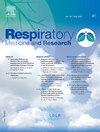Does occupational exposure affect the surgical management of patients with non-small cell lung cancer? A single-center retrospective experience
IF 1.8
4区 医学
Q3 RESPIRATORY SYSTEM
引用次数: 0
Abstract
Objective
Non-small-cell lung cancer (NSCLC) remains a major public health concern, with tobacco and environmental exposures to carcinogens (such as asbestos, radon, and silica) recognized as major risk factors. This study investigates the impact of occupational exposure, particularly to crystalline silica on peri‑ and postoperative outcomes in patients undergoing surgery for NSCLC.
Methods
A retrospective analysis was performed on 251 patients who underwent lobectomy or segmentectomy between 2018 and 2021, with occupational exposure data collected postoperatively.
Results
Our findings suggest that patients with occupational exposure, particularly to silica, asbestos, or multiple carcinogens, have more complex surgical courses, including longer operative times, higher rates of conversion from minimally invasive to open surgery, and increased postoperative complications (Clavien-Dindo grade II or higher). Preoperative lymph node staging was less accurate in exposed patients, in part because of inflammatory changes such as fibro-hyaline lesions, which can cause false-positive PET/CT findings.
Conclusions
The study highlights the need for tailored surgical strategies and accurate lymph node staging in exposed individuals. Future research should focus on prospective studies to refine perioperative management and explore the biological mechanisms driving these complications.
职业暴露会影响非小细胞肺癌患者的手术治疗吗?单中心回顾性研究
非小细胞肺癌(NSCLC)仍然是一个主要的公共卫生问题,烟草和环境暴露于致癌物(如石棉、氡和二氧化硅)被认为是主要的危险因素。本研究调查了职业暴露,特别是结晶二氧化硅对非小细胞肺癌手术患者围手术期和术后预后的影响。方法回顾性分析2018年至2021年251例肺叶或节段切除术患者,并收集术后职业暴露数据。结果我们的研究结果表明,职业性暴露的患者,特别是接触二氧化硅、石棉或多种致癌物的患者,手术过程更复杂,包括手术时间更长,从微创到开放手术的转换率更高,术后并发症增加(Clavien-Dindo II级或更高)。暴露患者的术前淋巴结分期不太准确,部分原因是炎症改变,如纤维透明病变,可能导致PET/CT结果假阳性。结论该研究强调了在暴露个体中需要量身定制的手术策略和准确的淋巴结分期。未来的研究应侧重于前瞻性研究,以完善围手术期管理,并探索导致这些并发症的生物学机制。
本文章由计算机程序翻译,如有差异,请以英文原文为准。
求助全文
约1分钟内获得全文
求助全文
来源期刊

Respiratory Medicine and Research
RESPIRATORY SYSTEM-
CiteScore
2.70
自引率
0.00%
发文量
82
审稿时长
50 days
 求助内容:
求助内容: 应助结果提醒方式:
应助结果提醒方式:


